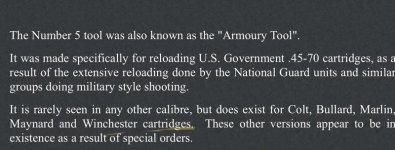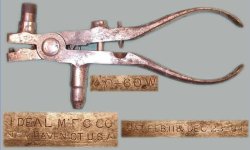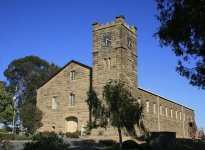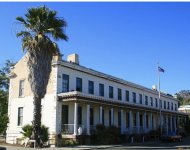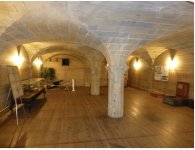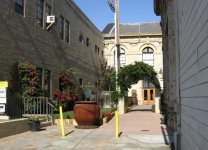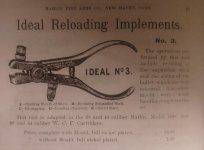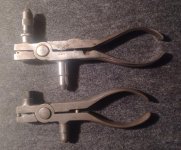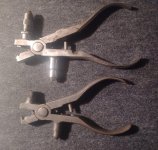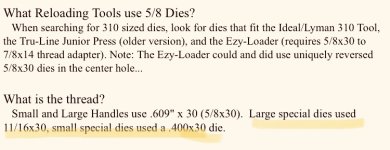You are using an out of date browser. It may not display this or other websites correctly.
You should upgrade or use an alternative browser.
You should upgrade or use an alternative browser.
45 S&W Schofield bullet mold C.D. Ladd
- Thread starter BMur
- Start date
- Joined
- Dec 1, 2022
- Messages
- 868
- Reaction score
- 1,409
Hi There,
I think you will find the No. 5 tool could be special ordered in
Rifle calibers. The example you have posted last is a First variation
No. 5 that was available in several rifle calibers from Winchester,
Ballard, Marlin, Colt, Maynard as well as the Government
.45-70. This is listed on the page I posted last time.
It was the Ideal No. 4 tool that was available in .45 S&W.
Cheers,
Webb
I think you will find the No. 5 tool could be special ordered in
Rifle calibers. The example you have posted last is a First variation
No. 5 that was available in several rifle calibers from Winchester,
Ballard, Marlin, Colt, Maynard as well as the Government
.45-70. This is listed on the page I posted last time.
It was the Ideal No. 4 tool that was available in .45 S&W.
Cheers,
Webb
Militia Arms
The one thing that you learn very quickly with research is you will never know it all.
After 40+ years I still find items that I have never seen before. In fact it happens often. It knocks you over unless you have an open mind. Put yourself in a bad place when you state absolutes. It's always better to state "known to exist".
Many authors spend countless hours researching and finally think they are ready to publish a book. Only to discover more information "after" the book is published. Or worse , they missed a huge piece to a very large puzzle!
Newly uncovered information is constantly flowing. Just when you think you've seen it all, something new pops up. That is my addiction because it never ends if you're willing to except the fact that you are "always" missing something.
The learning process never ends.
The 45 Schofield was part of the local Militia aka "The Guard" originating from The Benicia Arsenal in the Area that I grew up. See photos.
Over 300 were issued during the Railroad riots of the late 1870's to the local Guard. Likely more were actually in the Armory. I am not aware of any information regarding what happened to them but on occasion some do show up. The buildings are still actually there in Benicia and date before the Civil War.
It's not difficult to imagine a No.5 Armory tool special ordered in the 45 Schofield since it was an Armory reloading tool. The 45/70 Gov and 45 Schofield are like Peanut butter and jelly. Some information uncovered today is not in any books.
Downtown San Francisco at one time housed all of the major manufacturers! That includes Ideal, Winchester, Colt, and Smith &Wesson actually had a large office at 112 2nd Street. I never knew that until about 3 weeks ago while researching large Distributors.
So possibilities are endless and special order means exactly that.
My mind is wide open to new information.
Murph
The one thing that you learn very quickly with research is you will never know it all.
After 40+ years I still find items that I have never seen before. In fact it happens often. It knocks you over unless you have an open mind. Put yourself in a bad place when you state absolutes. It's always better to state "known to exist".
Many authors spend countless hours researching and finally think they are ready to publish a book. Only to discover more information "after" the book is published. Or worse , they missed a huge piece to a very large puzzle!
Newly uncovered information is constantly flowing. Just when you think you've seen it all, something new pops up. That is my addiction because it never ends if you're willing to except the fact that you are "always" missing something.
The learning process never ends.
The 45 Schofield was part of the local Militia aka "The Guard" originating from The Benicia Arsenal in the Area that I grew up. See photos.
Over 300 were issued during the Railroad riots of the late 1870's to the local Guard. Likely more were actually in the Armory. I am not aware of any information regarding what happened to them but on occasion some do show up. The buildings are still actually there in Benicia and date before the Civil War.
It's not difficult to imagine a No.5 Armory tool special ordered in the 45 Schofield since it was an Armory reloading tool. The 45/70 Gov and 45 Schofield are like Peanut butter and jelly. Some information uncovered today is not in any books.
Downtown San Francisco at one time housed all of the major manufacturers! That includes Ideal, Winchester, Colt, and Smith &Wesson actually had a large office at 112 2nd Street. I never knew that until about 3 weeks ago while researching large Distributors.
So possibilities are endless and special order means exactly that.
My mind is wide open to new information.
Murph
Attachments
Last edited:
- Joined
- Dec 1, 2022
- Messages
- 868
- Reaction score
- 1,409
Hi There,
I applaud you for keeping an open mind but when hearsay evidence
is presented as a fait accompli fact, I have to call 'BS' on that.
Once you have actual photo graphical evidence, then I will trumpet
your discovery.
You asked about the making of the spring for the Schofield. I have
to make some special equipment in order to set the necessary angles
that need to be machined. I have purchased a casting kit for a
lockable, rigid sine plate and it will take a while to machine and
grind the components and assemble. In the meantime, I am
concentrating on making the screws.
Cheers!
Webb
I applaud you for keeping an open mind but when hearsay evidence
is presented as a fait accompli fact, I have to call 'BS' on that.
Once you have actual photo graphical evidence, then I will trumpet
your discovery.
You asked about the making of the spring for the Schofield. I have
to make some special equipment in order to set the necessary angles
that need to be machined. I have purchased a casting kit for a
lockable, rigid sine plate and it will take a while to machine and
grind the components and assemble. In the meantime, I am
concentrating on making the screws.
Cheers!
Webb
Could an Ideal No.5 made for .45 Smith & Wesson be case of mistaken identity? Consider this...
Ideal No.3, Second Variation (1888-1892), as identified in Vol.1 of "Antique Reloading Tools of the Black Powder Era" by Tom Rowe and Ed Curtis.
This tool, which appears to be a scaled-down No.5 (or perhaps the No.5 was a scaled-up No.3), was advertised in Stevens, Marlin, Colt, and Merwin & Hulbert catalogs and is found in a variety of calibers from those manufacturers. It would not be too much of a stretch to suppose it might also have been special ordered for .45 Smith & Wesson. The first image below is from Marlin's 1888 catalog.
Seen alone, it would be easy to mistake this variation of the No.3 for a No.5. When viewed side-by-side, the size difference becomes obvious. The No.5 is a large tool, most suitable for rifle-size cartridges, while the No.3 is more appropriate for revolver-size. Another not-so-obvious difference is that in the No.3 the bullet sizer hole is located in the same handle as the seating chamber, while in the No.5 the sizer in in the opposite handle. Second and third images compare the No.3 (marked .38 W.C.F., with a muzzle resizing die, at the bottom) and No.5 (marked .45 GOV., with optional seating chamber for 500-grain bullet, at the top).
Jim
Ideal No.3, Second Variation (1888-1892), as identified in Vol.1 of "Antique Reloading Tools of the Black Powder Era" by Tom Rowe and Ed Curtis.
This tool, which appears to be a scaled-down No.5 (or perhaps the No.5 was a scaled-up No.3), was advertised in Stevens, Marlin, Colt, and Merwin & Hulbert catalogs and is found in a variety of calibers from those manufacturers. It would not be too much of a stretch to suppose it might also have been special ordered for .45 Smith & Wesson. The first image below is from Marlin's 1888 catalog.
Seen alone, it would be easy to mistake this variation of the No.3 for a No.5. When viewed side-by-side, the size difference becomes obvious. The No.5 is a large tool, most suitable for rifle-size cartridges, while the No.3 is more appropriate for revolver-size. Another not-so-obvious difference is that in the No.3 the bullet sizer hole is located in the same handle as the seating chamber, while in the No.5 the sizer in in the opposite handle. Second and third images compare the No.3 (marked .38 W.C.F., with a muzzle resizing die, at the bottom) and No.5 (marked .45 GOV., with optional seating chamber for 500-grain bullet, at the top).
Jim
Attachments
Ivan the Butcher
Member
Just curious: I saw a Tru-Line Jr. press for sale several years ago that had the normal 4-hole turret. in pairs 180 degrees from each other the hole were different sizes. 2 were definitely for Tru-Line/310 dies, the others were somewhat larger but nowhere as large as a 7/8"-14 sized hole. The question is, Did the Tru-Line only have a single size of die hole? making this a "Customized" press or did Lyman have a second diameter pair of holes?
I only have the newer 310/Tru-Line diameter dies (about 35 sets) and everything is a single diameter, but none are for larger diameter cartridges like 45-70. I believe the largest case diameter I have dies for is either for 38-55 WCF or 7.7mm Japanese.
Just about every year I load a small batch (50 or 100 rounds) of ammo with either a 310 tool or a Lee Loader tool, just to remind myself of how time consuming those systems were! I can't imagine being on a military detail to reload several hundred cartridges with tong tool!
I'm getting ready to load this year's batch, they will be in a with an early post WW2 set of 310 dies and tong marked "44 S&W" on the box. Since I have empties in Russian and Special lengths, I'll just do what the adjustments are already set for.
In your discussions about Schofield bullet diameter, I wonder if the modern "Cowboy" ammo with .451-.452" bullets and thicker case walls (.015-.017" as opposed to .009-.011"), will even chamber in original revolvers. Not having ANY Schofield's revolvers, the 750 rounds I acquired several years ago, fit and functioned just fine in modern 45 Colt revolvers (without recessed chambers) and carbines.
Ivan
I only have the newer 310/Tru-Line diameter dies (about 35 sets) and everything is a single diameter, but none are for larger diameter cartridges like 45-70. I believe the largest case diameter I have dies for is either for 38-55 WCF or 7.7mm Japanese.
Just about every year I load a small batch (50 or 100 rounds) of ammo with either a 310 tool or a Lee Loader tool, just to remind myself of how time consuming those systems were! I can't imagine being on a military detail to reload several hundred cartridges with tong tool!
I'm getting ready to load this year's batch, they will be in a with an early post WW2 set of 310 dies and tong marked "44 S&W" on the box. Since I have empties in Russian and Special lengths, I'll just do what the adjustments are already set for.
In your discussions about Schofield bullet diameter, I wonder if the modern "Cowboy" ammo with .451-.452" bullets and thicker case walls (.015-.017" as opposed to .009-.011"), will even chamber in original revolvers. Not having ANY Schofield's revolvers, the 750 rounds I acquired several years ago, fit and functioned just fine in modern 45 Colt revolvers (without recessed chambers) and carbines.
Ivan
Various die sizes
Most collectors and dealers are only familiar with the standard 5/8"X 30 TPI dies that are the most common found for the 310 tool. They will discount and disbelieve any suggestion of another size die available.
It's unfortunate when we take this stance but I've learned just to humor those folks and walk away. They never change their mind about anything.
I am aware of 3 separate sizes seen in attached photo.
Early Ideal tools having removable dies for small calibers came with very small dies.
Standard calibers came with the 5/8"X 30 TPI dies.
Then there is listed as "Special" calibers came with the 11/16X30 TPI dies.
I am not aware of a listing of calibers for the 11/16/30 TPI die but the few that I have seen are on the No.5 tool (Armory).
*** As I mentioned before I have also "never seen" a No.5 tool with a threaded adjustable loading die but they are clearly listed as available via special order.
That really is the factor in play here. A tool that embraces special order, listed in calibers by various manufacturers but not specific to actual caliber! Why not the 45 S&W?
Ivan, you've hit it exactly regarding identifying caliber specs of the original Commercial 45 Schofield as compared to the Frankford Arsenal Schofield. That's what this thread is all about but first you have to convince folks that there was a difference.
The letter I posted from Smith & Wesson is proof positive by itself but there will always be non believers.
I believe the original design case was a straight .470 diameter having a .449-.450 250 grain outside lubricated bullet.
I believe the Frankford Arsenal round mimic's the round actually introduced (in the letter!) by Smith & Wesson to function in both the Colt and the Schofield. That was a tapered round with a head diameter of about .478-.480 and a hollow based 230 grain flat nose lead bullet of about .452…. That would be the max size for the Schofield and functional in the Colt.
So, why didn't the commercial market alter the 45 Schofield tool to match the altered military round? Why are these tools made to fabricate the original unaltered round? Would the original Commercial round fit and function in a military altered Schofield?
These are the questions I have listed in my research.
Murph
Most collectors and dealers are only familiar with the standard 5/8"X 30 TPI dies that are the most common found for the 310 tool. They will discount and disbelieve any suggestion of another size die available.
It's unfortunate when we take this stance but I've learned just to humor those folks and walk away. They never change their mind about anything.
I am aware of 3 separate sizes seen in attached photo.
Early Ideal tools having removable dies for small calibers came with very small dies.
Standard calibers came with the 5/8"X 30 TPI dies.
Then there is listed as "Special" calibers came with the 11/16X30 TPI dies.
I am not aware of a listing of calibers for the 11/16/30 TPI die but the few that I have seen are on the No.5 tool (Armory).
*** As I mentioned before I have also "never seen" a No.5 tool with a threaded adjustable loading die but they are clearly listed as available via special order.
That really is the factor in play here. A tool that embraces special order, listed in calibers by various manufacturers but not specific to actual caliber! Why not the 45 S&W?
Ivan, you've hit it exactly regarding identifying caliber specs of the original Commercial 45 Schofield as compared to the Frankford Arsenal Schofield. That's what this thread is all about but first you have to convince folks that there was a difference.
The letter I posted from Smith & Wesson is proof positive by itself but there will always be non believers.
I believe the original design case was a straight .470 diameter having a .449-.450 250 grain outside lubricated bullet.
I believe the Frankford Arsenal round mimic's the round actually introduced (in the letter!) by Smith & Wesson to function in both the Colt and the Schofield. That was a tapered round with a head diameter of about .478-.480 and a hollow based 230 grain flat nose lead bullet of about .452…. That would be the max size for the Schofield and functional in the Colt.
So, why didn't the commercial market alter the 45 Schofield tool to match the altered military round? Why are these tools made to fabricate the original unaltered round? Would the original Commercial round fit and function in a military altered Schofield?
These are the questions I have listed in my research.
Murph
Attachments
Last edited:
Ivan the Butcher
Member
Thanks for these insights, and all the other information you've pouring out on us!
Ivan
Ivan
- Joined
- Dec 1, 2022
- Messages
- 868
- Reaction score
- 1,409
Hi There,
"Then there is listed as "Special" calibers came with the 11/16X30 TPI dies."
I am aware of only two calibers that were available in these size dies.
They are the 50-70 and the 348 Win. calibers. There may be others.
Those two calibers are the only ones I have personally encountered.
I have one handle that is threaded for this size.
"I only have the newer 310/Tru-Line diameter dies (about 35 sets) and everything is a single diameter, but none are for larger diameter cartridges like 45-70. I believe the largest case diameter I have dies for is either for 38-55 WCF or 7.7mm Japanese"
The 45-70 was available in the standard 5/8"-30tpi dies. I have
a set of them. They were available fairly recently due to the "Cowboy
Action" craze that brought back a lot of the classic calibers but
that has passed now.
My first set of reloading dies I got were .41 Colt Long. This is an
older set of 310 dies with 5 dies. More resent die sets use 4 dies.
This is because the earlier die sets used separate muzzle re-sizer
and universal de-priming dies. Later sets combined these two
operations into one die.
Cheers,
Webb
"Then there is listed as "Special" calibers came with the 11/16X30 TPI dies."
I am aware of only two calibers that were available in these size dies.
They are the 50-70 and the 348 Win. calibers. There may be others.
Those two calibers are the only ones I have personally encountered.
I have one handle that is threaded for this size.
"I only have the newer 310/Tru-Line diameter dies (about 35 sets) and everything is a single diameter, but none are for larger diameter cartridges like 45-70. I believe the largest case diameter I have dies for is either for 38-55 WCF or 7.7mm Japanese"
The 45-70 was available in the standard 5/8"-30tpi dies. I have
a set of them. They were available fairly recently due to the "Cowboy
Action" craze that brought back a lot of the classic calibers but
that has passed now.
My first set of reloading dies I got were .41 Colt Long. This is an
older set of 310 dies with 5 dies. More resent die sets use 4 dies.
This is because the earlier die sets used separate muzzle re-sizer
and universal de-priming dies. Later sets combined these two
operations into one die.
Cheers,
Webb
Ivan the Butcher
Member
The 44 S&W die set I'm using is old enough to be 5 dies. I noticed last night that the handles are marked "44 S&W" too. The box is labeled Lyman Ideal, but the handles are old stock that only say Ideal. The 1970's handles I have are cast aluminum and marked Lyman. I also have chrome plated handles marked "22 H" that came with Hornet dies (5 piece set) and a small separate box with same mailing address (a house in Columbus, Ohio that was destroyed for I-70) and postmark (1953 postmark) for "22 K Hornet".
Around here, nobody seems to have wanted any dies or tong tools for the large or Special cartridges, I've never seen any, even at the OGCA shows I went to in the 80's.
Thanks again for all the info.
Ivan
Around here, nobody seems to have wanted any dies or tong tools for the large or Special cartridges, I've never seen any, even at the OGCA shows I went to in the 80's.
Thanks again for all the info.
Ivan
Similar threads
- Replies
- 6
- Views
- 861

